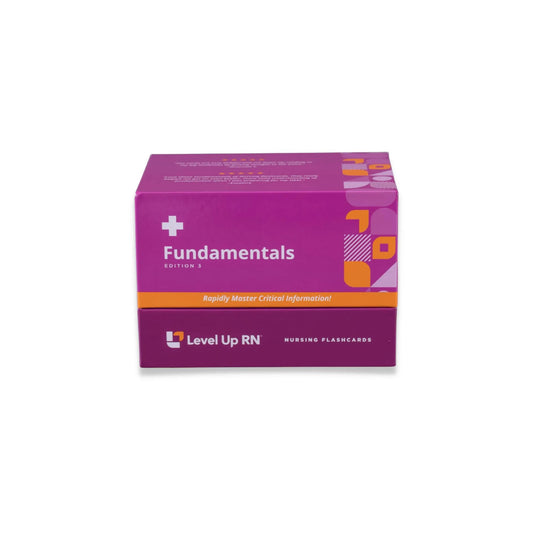In this article, we'll cover the chain of infection and the stages of infection. We'll use COVID-19 as an example to help you understand some of these steps!
The Fundamentals of Nursing video series follows along with our Fundamentals of Nursing flashcards, which are intended to help RN and PN nursing students study for nursing school exams, including the ATI, HESI, and NCLEX.
The chain of infection
The chain of infection describes how a pathogen gets from where it is to where it's going. It starts with the infectious agent, which lives in a reservoir, finds a portal of exit, and uses a mode of transmission to find a portal of entry into a susceptible host.
Fundamentals of Nursing - Flashcards
Infectious agent
First in the chain of infection is the infectious agent, which is an organism capable of causing infection or disease. Examples of infectious agents include bacteria, viruses, fungi, and parasites.
For example, COVID-19 is an infectious agent.
Reservoir
The reservoir is where the infectious agent lives and multiplies. A reservoir could be a body of water, human, or animal.
In the case of COVID-19, a person could be a reservoir for the virus.
Portal of exit
The portal of exit is the way that the infectious agent leaves its reservoir. If a person is the reservoir for the pathogen, the portal of exit could be their nose and mouth when sneezing, their blood (a bloodborne pathogen), or the infectious agent could exit fecally.
For example, COVID-19's portal of exit is the nose and mouth, which is why masks are worn.
Mode of transmission
The mode of transmission explains how the infectious agent gets from the reservoir to the new host. The portal of exit is just how the pathogen exited, but the mode of transmission explains how it travels from there. This can include direct contact, respiratory droplets, airborne, vehicles like water or food, or vectors like mosquitoes, ticks, or fleas.
In the case of COVID-19, its mode of transmission is respiratory droplets. This is why social distancing and limited gatherings are essential to stop the spread; fewer people around each other, fewer respiratory droplets flowing through the air. If you have COVID and you and your respiratory droplets are alone in your home, they can't reach the next item on the list—a portal of entry to a susceptible host.
Portal of entry
The portal of entry is how the infectious agent enters into the new host. This could be through the nose and mouth, through the eyes, or through the bloodstream (e.g., into an open wound). The portal of entry may be the same as the portal of exit.
For example, COVID-19's respiratory droplet portal of entry is the nose and mouth, which is again why masks are worn to protect against the virus.
Susceptible host
A susceptible host is the recipient of the infection. The host must be susceptible; and not all hosts are susceptible. Hosts might not be susceptible because they have had the disease previously and developed antibodies against it. Some hosts have stronger immune systems than others, e.g., someone who is immunocompromised is a more susceptible host.
In the case of COVID-19, getting vaccinated makes you a less susceptible host.
The stages of infection
The stages of infection describe what happens once a susceptible host has acquired a pathogen. The stages are: incubation, prodromal, illness, and convalescence.
Incubation stage
The incubation period of infection is the time from when the pathogen first gets in the body, until it starts to make its appearance known. During this time, the pathogen is multiplying inside your body. One does not know they are sick at this time.
Diseases or infections with a long incubation period are concerning because a person might be contagious long before they know they are sick, and they may not know to take precautions against spreading the illness.
Prodromal stage
The prodromal period of infection is when general, non-specific signs and symptoms of illness appear. These symptoms are vague, not specific to any one disease.
If you have ever woken up in the morning and thought, "I don't really feel very well. I can't tell you what's wrong. I'm just tired. I don't feel good. I feel kind of fatigued and weak," that was the prodromal stage at work.
Illness stage
During the illness phase, infection-specific signs and symptoms appear.
For example, a patient may have a high fever, a cough, and body aches if they are in the illness phase of influenza. If a patient has gastroenteritis, they might have an upset stomach, cramps, nausea, vomiting, or diarrhea.
If you'd like to learn the key facts about influenza, gastroenteritis, and more infections, diseases and disorders, check out our best-selling Medical-Surgical Nursing Flashcards.
Convalescence stage
Last in the stages of infection is the convalescence stage, which is the recovery from infection. To convalesce means to get better. During the convalescence stage, symptoms start to disappear until a person is fully healed.
If an illness is something like the common cold, the convalescence stage might be just a few days. If it's a serious or long-lasting infection, the convalescence stage could take a very long time.



1 comment
This manuscript is beneficial and informative.